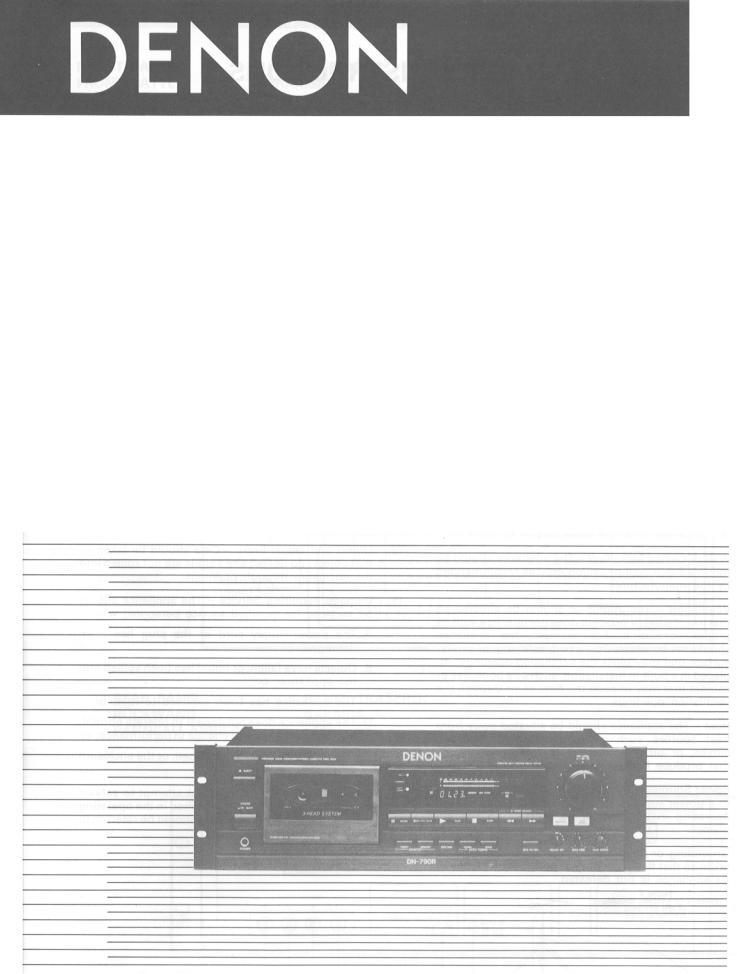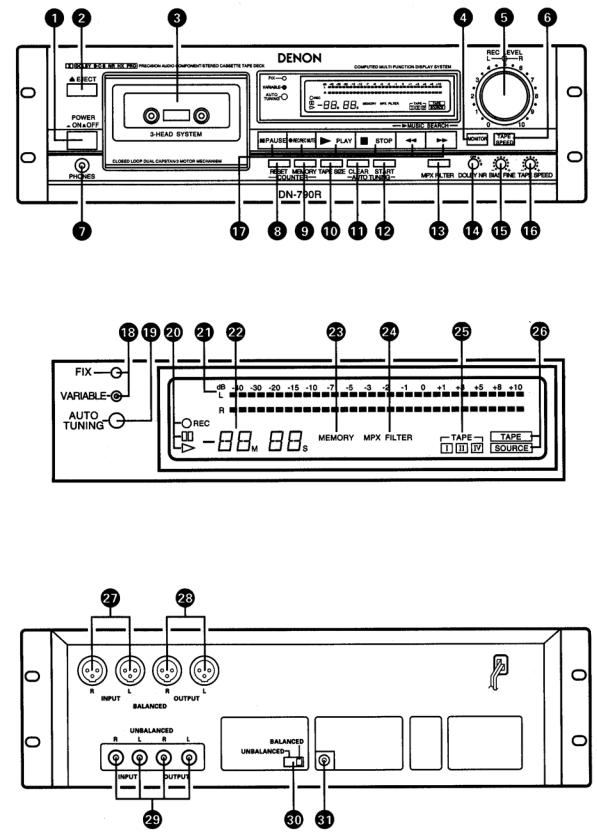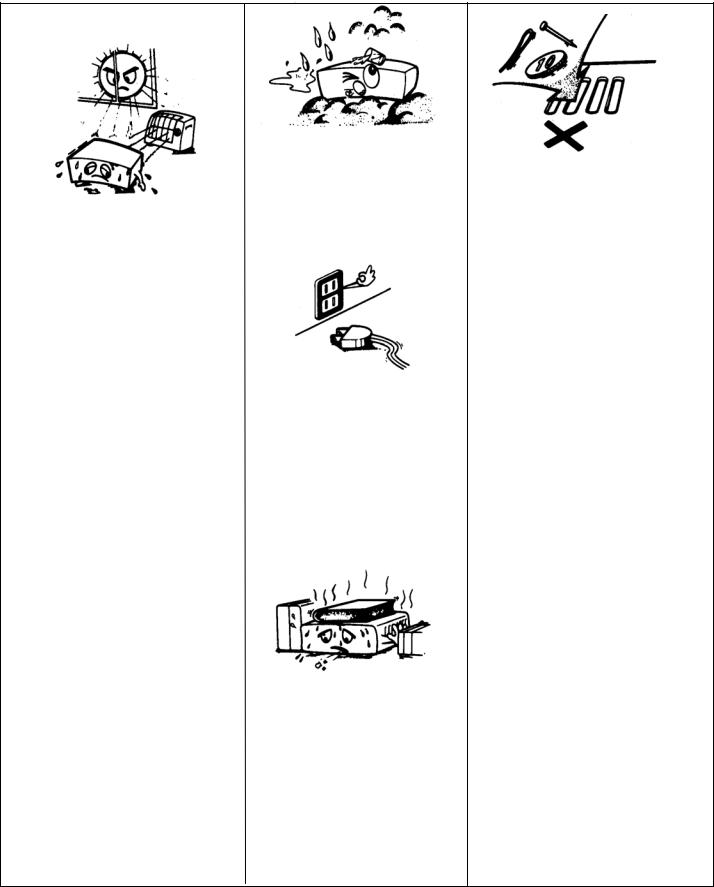Denon DN-790R Owners Manual

STEREO CASSETTE TAPE DECK
DN-790R
OPERATING INSTRUCTIONS

IMPORTANT TO SAFETY
WARNING:
TO PREVENT FIRE OR SHOCK HAZARD, DO NOT EXPOSE THIS APPLIANCE TO RAIN OR MOISTURE.
CAUTION:
1.Handle the power supply cord carefully
Do not damage or deform the power supply cord. If it is damaged or deformed, it may cause electric shock or malfunction when used. When removing it from wall outlet, be sure to remove by holding the plug attachment and not by pulling the cord.
2.Do not open the top cover In order to prevent electric shock, do not open the top cover. If problems occur, contact your DENON DEALER.
3.Do not place anything inside Do not place metal objects or spill liquid inside the cassette tape deck. Electric shock or malfunction may result.
Please, record and retain the Model name and serial number of your set
shown on the rating label. |
|
Model No. DN 790R |
Serial No. |
FOR U.S.A. & CANADA MODEL ONLY
CAUTION
TO PREVENT ELECTRIC SHOCK DO NOT USE THIS (POLARIZED) PLUG WITH AN EXTENSION CORD, RECEPTACLE OR OTHER OUTLET UNLESS THE BLADES CAN BE FULLY INSERTED TO PREVENT BLADE EXPOSURE.
2

FRONT PANEL
DISPLAY
REAR PANEL
3

SAFETY INSTRUCTIONS
1.Read Instructions – All the safety and operating instructions should be read before the applicance is operated.
2.Retain Instructions – The safety and operating instructions should be retained for future reference.
3.Heed Warning – All warnings on the applicance and in the operating instructions should be adhered to.
4.Following Instructions – All opeerating and use instructions should be followed.
5.Water and Moisture – The appliance should not be used near water – for example, near a bathtub, washbbowl, kitchen sink, laundry tub, in a wet basement, or near a swimming pool, and the like.
6.Carts and Stands – The appliance should be used only with a cart or stand that is recommended by the manufacturer.
6A. An appliance and cart combination should be moved with care. Quick stops, excessive force, and uneven surfaces may cause the applicance and cart
combination to overturn.
7.Wall or Ceiling Mounting – The appliance should be mounted to a wall or ceiling only as recommended by the manufacturer.
8.Ventilation – The appliance should be situated so that its location or position does not interfere with its proper ventilation. For example, the appliance should not be situated on a bed, sofa, rug, or similar surface that may block the ventilation openings; or, placed in a built-in installation, such as a bookcase or cabinet that may impede the flow of air through the ventilation openings.
9.Heat – The appliance should be situated away from heat sources such as radiators, heat registers, stoves, or other appliances (including amplifiers) that produce heat.
10.Power Sources – The appliance should be connected to a power supply only of the type described in the operating instructions or as marked on the appliance.
11.Grounding or Polarization – Precautions should be taken so that the grounding or polarization means of an appliance is not defeated.
FIGURE A |
|
EXAMPLE OF ANTENNA GROUNDING |
|
AS PER NATIONAL |
|
ELECTRICAL CODE |
ANTENNA |
|
LEAD IN |
|
WIRE |
GROUND |
|
CLAMP |
|
|
ANTENNA |
|
DISCHARGE UNIT |
|
(NEC SECTION 810 20) |
ELECTRIC |
|
SERVICE |
|
EQUIPMENT |
GROUNDING CONDUCTORS |
|
|
|
(NEC SECTION 810 21) |
|
GROUND CLAMPS |
|
POWER SERVICE GROUNDING |
|
ELECTRODE SYSTEM |
NEC NATIONAL ELECTRICAL CODE |
(NEC ART 250, PART H) |
|
12.Power-Cord Protection – Power-supply cords should be routed so that they are not likely to be walked on or pinched by items placed upon or against them, paying particular attention to cords at plugs, convenience receptacles, and the point where they exit from the appliance.
14.Cleaning – The appliance should be cleaned only as recommended by the manufacturer.
15.Power Lines – An outdoor antenna should be located away from power lines.
16.Outdoor Antenna Grounding – If an outside antenna is connected to the receiver, be sure the antenna system is grounded so as to provide some protection against voltage surges and built-up static charges. Article 810 of the National Electrical Code, ANSI/NFPA 70, provides information with regard to proper grounding of the mast and supporting structure, grounding of the lead-in wire to an antenna-discharge unit, size of grounding conductors, location of antenna-discharge unit, connection to grounding electrodes, and requirements for the grounding electrode. See Figure A.
17.Nonuse Periods – The power cord of the appliance should be unplugged from the outlet when left unused for a long period of time.
18.Object and Liquid Entry – Care should be taken so that objects do not fall and liquids are not spilled into the enclosure through openings.
19.Damage Requiring Service – The appliance should be serviced by qualified service personnel when:
A.The power-supply cord or the plug has been damaged; or
B.Objects have fallen, or liquid has been spilled into the appliance; or
C.The appliance has been exposed to rain; or
D.The appliance does not appear to operate normally or exhibits a marked change in performance; or
E.The appliance has been dropped, or the enclosure damaged.
20.Servicing – The user should not attempt to service the appliance beyond that described in the operating instructions. All other servicing should be referred to qualified service personnel.
4

NOTE ON USE
Avoid high temperatures
Allow for sufficient heat dispersion when installed on a rack.
Handle the power cord carefully. Hold the plug when unplugging the cord.
Keep the set free from moisture, water, and dust.
Unplug the power cord when not using the set for long periods of time.
"(For sets with ventilation holes)
Do not obstruct the ventilation holes.
Do not let foreign objects in the set.
Do not let insecticides, benzene, and thinner come in contact with the set.
Never disassemble or modify the set in any way.
5
